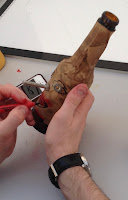
During my Research Methodology project, my work focused on fish. In my opinion, fish are very interesting for various reasons, such as their colourful and shiny scales, and the incredibly diverse shapes and sizes they come in, ranging from a great white shark, to the tiny goby, which is about the size of your finger nail. Starting off, I began looking at the anatomy and biology of fish. I did this by drawing visually diverse fish species, such as the thin mackerel, or the blob like trunk fish. I also researched different types of fish scale, and researched how their gills work. In short, they take in water into their gills, then oxygen is extracted from the water, then flushed back out.
After the first tutorial, I began researching a lot more things in relation to fish. I also had the opportunity to experiment with a wide range of materials, such as the Wacom Cintiq, a graphics tablet where you can draw directly onto the screen. The Wacom Cintiq tablet is a piece of equipment that really interests me as a wannabe digital painter. During the project I created various illustrations using this tablet, such as the image below, a visual experiment from my research into skittish fish behavior. It is inspired by the African Trout, which are known as particularly skittish fish, due to the abundance of predators in Africa, such as cormorants, otters and humans.

In order to explore new research methodologies, I created a survey which I shared online for other people to answer. I used the survey to get peoples opinions on a range of topics regarding fish. From the survey I came to the conclusion that most people only really cared about fish in terms of food and keeping as a pet. Some stated they were important as they keep the marine environment clean. Therefore from the survey, I wanted to further explore themes of marine ecology and the effects of water pollution. I wanted to make something visually communicative that might take the appearance of a visual metaphor and subtly shock people about the impact of water pollution.
The most interesting of my five words i researched were "Struggling" and "Diversity". An article from Credo told me how pollution was responsible for an alarmingly high amount of fish species extinction. Below is one of the visual experiments from the five word methodology, an image that shows both fish diversity, and the struggle of water pollution, represented by the littered pattern on the fish and how fish are having to adapt to these polluted environments and die due to mutations or habitat loss.
With this I found something I wanted to communicate. After researching all of my words, I decided to take what I had learned from these two further. That water pollution is heavily affecting marine ecology and is responsible for reducing diversity in fish species, as most species are dying out. After evaluating multiple ideas I decided to create a communicative sculpture which would act as a visual metaphor and communicate to people how drastically pollution is affecting marine ecology and the diversity of fish species.

The sculpture itself is made up of a slate base, and an arch made from two driftwood pieces. I added both natural and unnatural elements to the sculpture, to show how the ecosystem is drastically changing due to pollution, such as shells, barnacles, fishing wire and glass. The sculpture itself communicates the effects on the ecosystem well, however the two aluminum fish communicate the effect of pollution on fish diversity and biology well. There are only two fish, and both are made of the same materials, and are exactly the same shape. This subtly communicates how fish have to adapt to the pollution, as well as visually representing a lack in diversity, again due to pollution. The fact that they are made of cider cans communicates fish mutation, which I learned about from a Credo article, which is one of the key reasons why diversity is decreasing, fish are mutating and dying due to their polluted waters. I hope that my sculpture will bring this to people's attention and shock them about the frightening truth.

















































